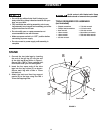
GENERAL POWER TOOL SAFETY RULES
3
continued on page 4
Failure to follow these rules may
result in serious personal injury.
1. READ INSTRUCTION MANUAL AND KNOW YOUR
TOOL. Read and familiarize yourself with entire
instruction manual. Learning the tool’s proper
applications, limitations, and specific potential
hazards will greatly minimize the possibility of
accidents and injury. Make sure all users are familiar
with its warnings and instructions before using tool.
2. KEEP GUARDS AND SAFETY DEVICES IN PLACE
and working properly.
3. REMOVE ADJUSTING KEYS AND WRENCHES.
Form habit of checking to see that all adjusting keys
and wrenches are removed before starting tool.
4. KEEP WORK AREA CLEAN AND WELL LIT.
Cluttered or poorly-lit work areas, surfaces and
benches can lead to accidents.
5. DO NOT USE OR STORE TOOL IN DANGEROUS
ENVIRONMENTS. Exposure to rain and damp or
wet locations can result in shock or electrocution,
or damage the tool. Do not operate electric tools
near flammable liquids or in gaseous or explosive
atmospheres. Motors and switches in these tools
may spark and ignite fumes.
6. KEEP CHILDREN AND BYSTANDERS AWAY from
work area.
7. LOCK TOOLS AND WORK AREA. Use padlocks,
and master switches, or remove and store starter
keys to prevent operation by children and other
unauthorized users.
8. DO NOT FORCE TOOL OR WORKPIECE. Operate
tool at intended speed and feed rate for better and
safer operation.
9. USE PROPER TOOL. Do not force tool to do a task
for which it was not designed.
10. DO NOT ABUSE POWER CORDS. NEVER yank
cord to disconnect from receptacle, crush cord, or
expose it to heat, oil or sharp objects.
11. USE PROPER EXTENSION CORD. If you use an
extension cord, make sure it is in good condition
and heavy enough to carry the current your product
will draw. An undersized cord will cause a drop
in line voltage, resulting in loss of power and
overheating. See Extension Cord Chart for correct
size depending on cord length and data plate
ampere rating. If in doubt, use the next smaller
gauge number. The smaller the gauge number, the
heavier the cord. When working outside, make sure
extension cord is rated for outdoor use. Consult
power connection section of this manual for
Extension Cord Chart and power connection safety.
12. SECURE WORKPIECE. Use clamps or a vise to
hold the workpiece when practical. It is safer than
using your hands and frees both hands to operate
tool.
13. DO NOT OVERREACH. Keep proper footing and
balance to maintain control.
14. MAINTAIN TOOLS WITH CARE. Keep tools
sharp and clean for best and safest performance.
Follow instructions for lubricating and changing
accessories.
15. DISCONNECT TOOL from power source before
servicing, adjusting or changing set-ups or blades,
bits, cutters and other accessories.
16. TO REDUCE RISK OF ACCIDENTAL STARTING,
make sure power switches are in “OFF” position
before plugging tool in.
17. Do not touch the plug’s metal prongs when
unplugging or plugging in the cord.
CAREFULLY READ AND FOLLOW ALL WARNINGS AND INSTRUCTIONS ON YOUR PRODUCT
AND IN THIS MANUAL. SAVE THIS MANUAL. MAKE SURE ALL USERS ARE FAMILIAR WITH ITS
WARNING AND INSTRUCTIONS WHEN USING THE TOOL. Improper operation, maintenance or modification of
tools or equipment could result in serious injury and/or property damage.
If you have any questions or concerns relative to the use of your tool or the contents of this manual, stop using the
tool and contact DELTA
®
Power Equipment Corporation Customer Care at 1-800-223-7278.
SAFETY LOGOS
The definitions below describe the level of severity for each signal word. Please read the manual and pay attention
to these symbols.
Indicates an imminently hazardous situation which, if not avoided, will result in death or serious
injury.
Indicates a potentially hazardous situation which, if not avoided, could result in death or serious
injury.
Indicates a potentially hazardous situation which, if not avoided, may result in minor or moderate
injury.
IMPORTANT SAFETY INSTRUCTIONS


















